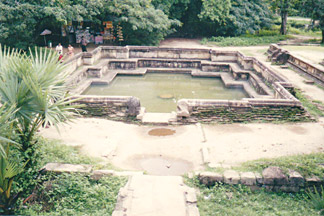Our irrigation heritage in retrospect
M U A Tennakoon - PhD, DSc Former Executive
Director, Central Bank of Sri Lanka
Sri Lanka has more than a 2,500 years old recorded history of
irrigation, that is surpassed only by Egypt, Messopotamia, Indus valley
in India and China dating back to 4,000 to 6,000 years. The uniqueness
in Sri Lankan tank-based irrigation is that reservoirs are constructed
on hard-rock bases across streams ephemeral or perennial in ‘etched’
plains to store water for irrigation and to meet all other human needs
during the dry seasons. In all other countries mentioned above, the deep
alluvial soil deposits in the river banks of Nile, Tigris, Euphrates,
Indus, Yellow River basin etc., sometimes as thick as 30 metres, are
irrigated by the natural river up-swellings and flooding.
|

Kuttanpokuna |
Parker (1909) commenting on ancient irrigation in Sri Lanka states
that “Pandae-waewa’, (presently known as Pandawewa) near Hettipola in
the North Western Province, built across the Kolamune Oya, believed to
have been constructed in the first half of the 4th century BC, would be
the first great reservoir ever constructed, if we omit from
consideration the great lakes of Egypt, since they were merely immense
natural hollows into which the river water was turned”. It was also the
Sri Lankan engineers who, for the first time at least by 300.B.C,
invented those remarkable cistern (bisokotuwa) type sluices for our
tanks, the device, for which the western scientists had to wait until
the 18th century to invent. A large reservoir like ‘Pandae-waewa’
referred to by Parker (1909) would have required sophisticated
bisokotuwa type sluices built using bricks and stone.
There were many other design and construction achievements of our
‘master engineers’ in that distant past. Human ingenuity and endurance
discernible in perfected irrigation planning, designing and construction
completed by our spirited engineers in that distant past, induce us to
be proud of them, to learn more about them, and to let the world know
about their ingenious irrigation task functions. But we should not be
unnecessarily emotional, over-patriotic or too boastful in laying open
the intricacies of our irrigation civilization before the world. We need
to have a descent scientific methodological approach well balanced in
this display of sense and substance of our irrigation heritage
patiently, intelligently and scholarly well distanced from boasting. We
need to be Parakrama Bhahus and not Nissanka Malalas.
Before we set upon a methodology to do a balanced display of our
irrigation heritage before the world, let us understand what irrigation
means and what are its functional components. Irrigation is any form of
water supply to land to grow any type of crop or plant stress-free, in
times of water shortage. Irrigation functions are : i. water collection;
ii. water storing; iii. water release as and when necessary; iv. water
conveyance to where it is necessary and v. water use for necessary
purposes.
Water collection
|

Ancient irrigation site |
It includes receiving rainwater from the intended storage’s catchment
and water received from all other up-stream sources - tanks, springs,
streams and diverted canal supplies from other large sources of water
etc.
Water storage
Water is stored on the surface of land in ponds, villus, meadows,
sink holes, small tanks (wewas) and in large reservoirs. These together
contain the largest volume of fresh water collection on the earth’s land
surface. Water is also made to accumulate in aquifers as groundwater,
where geology favours their existence.
The active aquifers in Sri Lanka are: i. Shallow karstic aquifer of
Jaffna Peninsula; ii. Deep confined aquifers; iii. Coastal sand
aquifers; iv. Alluvial aquifers; v. Shallow regolith aquifers of the
hard rock region; and vi. South western lateritic (cabook) aquifers. (Panabokke,
2005). In some areas, if not for the availability of this precious
groundwater, human sustenance, both in terms of agriculture and other
human needs, would not have been possible.
To be continued next week |



